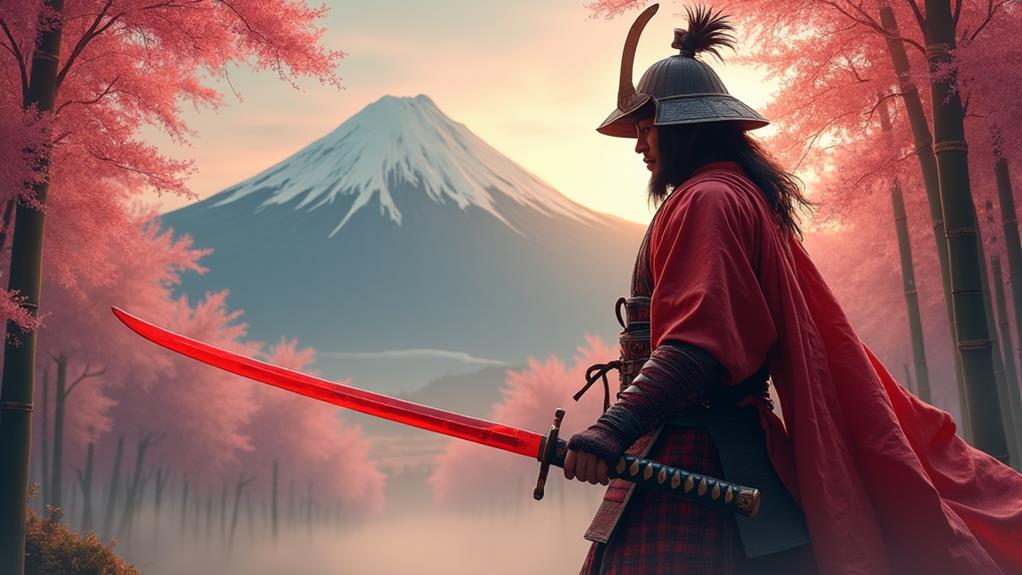
Red katanas emerged during Japan's late Heian period, crafted through specialized techniques using copper alloys and heat treatments. These striking swords evolved from aesthetic marvels to powerful symbols of passion and spiritual force in feudal Japan. Samurai wielding red-bladed katanas were seen as formidable warriors with unwavering spirits. The swords played significant roles in ceremonies, rituals, and important life events. They were associated with legendary figures and historical samurai, often attributed with magical properties in folklore. The unique forging process and cultural significance of red katanas have cemented their place in Japanese history and continue to captivate imaginations today.
Key Takeaways
- Red-bladed katanas originated in the late Heian period through specialized forging techniques using copper alloys and heat treatment.
- These swords symbolized power, passion, and life force in feudal Japan, with samurai wielders seen as formidable warriors.
- Red katanas played significant roles in Japanese ceremonial and ritual practices, representing deities and marking important life events.
- Legendary figures and historical samurai were associated with red katanas, enhancing their cultural significance and mystique.
- The unique forging process and materials used in red katanas contributed to their functionality, durability, and distinct appearance.
Origins of Red-Bladed Katanas
Throughout Japanese history, red-bladed katanas have been shrouded in mystery and legend. These distinctive swords originated during the late Heian period (794-1185 AD) when swordsmiths began experimenting with unique blade designs. The crafting of these swords was not only a reflection of artistry but also involved the craftsmanship and artistry of sword-making, resulting in blades that were as much functional weapons as they were symbols of status.

The red hue was achieved through specialized manufacturing processes involving the use of copper alloys and heat treatment techniques. Swordsmiths closely guarded these methods, adding to the swords' mystique.
Red katanas were initially created for aesthetic purposes, but they soon gained spiritual and symbolic significance. Some believed the red color represented the blood of fallen enemies, while others saw it as a symbol of power and authority. As demand grew, craftsmen refined their techniques, producing blades with varying shades of red. These swords became highly prized possessions among samurai and nobility, often passed down through generations as family heirlooms.
Symbolism and Cultural Significance
While red katanas were initially prized for their aesthetic appeal, they quickly evolved to embody profound symbolic and cultural significance in Japanese society. The vibrant crimson blades came to represent power, passion, and the life force itself.
In feudal Japan, samurai who wielded red katanas were seen as formidable warriors with an unwavering spirit, reflecting the ideals of bravery and honor that are deeply rooted in Japanese swords. These swords also developed strong religious associations. Buddhist monks sometimes used red-bladed katanas in ceremonies, believing the color channeled spiritual energy. Some viewed the red blade as a path to spiritual enlightenment, symbolizing the transformation of the wielder's soul.
The cultural impact of red katanas extended beyond the battlefield and religious practices. They became status symbols, often presented as gifts to honor distinguished individuals or mark significant events in Japanese history.
Forging Techniques and Materials
Employing specialized techniques and rare materials, Japanese swordsmiths crafted red katanas through a meticulous process. The creation of these distinctive blades involved advanced metallurgy processes and precise heat treatment methods.
Swordsmiths carefully selected high-carbon steel, often combining it with softer iron to achieve the desired balance of strength and flexibility. The unique features of the katana's blade, such as the blade components like nagasa and hamon, further contributed to the functionality of these remarkable swords.

The red coloration was typically achieved through the application of copper alloys during forging or by using specialized polishing compounds. Heat treatment played a pivotal role in developing the blade's hardness and resilience. Swordsmiths utilized differential hardening techniques, creating a harder edge and a more flexible spine.
This process, known as clay tempering, involved coating the blade with clay before quenching, resulting in the characteristic hamon pattern along the edge. These methods guaranteed that red katanas maintained both their unique appearance and exceptional cutting ability.
Ceremonial and Ritual Uses
The distinctive red katanas, forged with such meticulous care, held significant roles in Japanese ceremonial and ritual practices. Understanding the importance of katana structure enhances our appreciation of these historical blades. These swords were not merely weapons but symbols of power, honor, and spiritual significance.
In religious ceremonies and formal presentations, red katanas were often used to:
- Represent the presence of deities
- Perform symbolic purification rituals
- Demonstrate loyalty and allegiance to a lord or clan
- Mark important life events, such as coming-of-age ceremonies
The vibrant red color of these katanas was believed to possess protective qualities, warding off evil spirits and bringing good fortune to their wielders. During formal presentations, the display of a red katana signified the importance of the occasion and the status of those involved. These ceremonial uses reinforced the katana's central role in Japanese culture, extending far beyond its practical applications in warfare.
Historical Figures and Legends
Throughout Japanese history, numerous legendary figures and historical samurai have been associated with red katanas, contributing to the mystique and cultural significance of these distinctive weapons. Several samurai leaders and ancient warlords were known to wield red-bladed swords, which became symbols of their power and authority.

These legendary warriors, such as Oda Nobunaga and Date Masamune, often used their red katanas as a means of intimidation and to showcase their status on the battlefield. In folklore, red katanas were sometimes attributed magical properties, believed to possess the ability to cut through evil spirits or grant their wielders superhuman strength. These stories and historical accounts have solidified the red katana's place in Japanese culture as a symbol of power, courage, and spiritual significance, influencing art, literature, and popular media for generations.
Red Katanas in Modern Media
Red katanas have maintained their allure and symbolism in modern media, extending their cultural significance far beyond historical accounts and folklore. These iconic weapons continue to enthrall audiences through various fan favorite depictions and modern interpretations. Their presence in popular culture reinforces their status as powerful symbols of honor, skill, and determination.
Red katanas frequently appear in:
- Anime and manga series
- Video games and role-playing games
- Hollywood action films
- Collectible memorabilia and replicas
These modern media representations often blend traditional Japanese aesthetics with contemporary storytelling, creating a compelling fusion of past and present. By incorporating red katanas into diverse forms of entertainment, creators tap into the weapon's rich cultural heritage while adapting its symbolism to resonate with modern audiences. This ongoing evolution guarantees that red katanas remain relevant and mesmerizing in today's media landscape.
Frequently Asked Questions
Are Red Katanas More Expensive Than Traditional Katanas?
Red katanas can be more expensive due to specialized blade composition and unique blade heat treatment processes. However, pricing ultimately depends on craftsmanship, materials, and historical significance. Traditional katanas may also command premium prices for similar reasons.
Can Red Katanas Be Legally Owned and Collected Outside of Japan?
The private ownership and collection of red katanas outside Japan is generally legal, subject to local regulations. However, collectors should be aware of the cultural significance and exercise responsible stewardship when acquiring these unique weapons.
How Does the Red Blade Affect the Katana's Cutting Performance?
The red blade's composition typically results in increased durability and improved edge retention, enhancing the katana's cutting performance. This allows for more precise and controlled cuts, potentially improving the weapon's overall effectiveness in skilled hands.
Are There Any Specific Maintenance Requirements for Red-Bladed Katanas?
Red-bladed katanas require meticulous care. Proper storage techniques, including climate-controlled environments and oil application, are critical. Regular sharpening requirements must be met to maintain optimal performance. Adherence to these maintenance protocols guarantees longevity and functionality of the blade.
Do Red Katanas Have Any Practical Advantages in Combat Situations?
Red katanas offer potential tactical advantages in combat situations. Improved visibility in low light environments enhances wielder precision, while the striking color may increase psychological impact on opponents. However, these benefits are largely theoretical and not historically substantiated.
Conclusion
Red-bladed katanas hold a unique place in Japanese culture, blending historical significance with symbolic meaning. Their origins, forging techniques, and ceremonial uses reflect deeper cultural values. From legendary historical figures to modern media representations, these distinctive swords continue to captivate imaginations. While their practical use has diminished, red katanas remain powerful symbols of Japanese heritage, martial prowess, and artistic craftsmanship. Their enduring presence in cultural narratives underscores their importance beyond mere weaponry. Musashi Swords are renowned examples of these iconic blades, embodying the rich tradition and craftsmanship associated with red katanas in Japanese culture.


